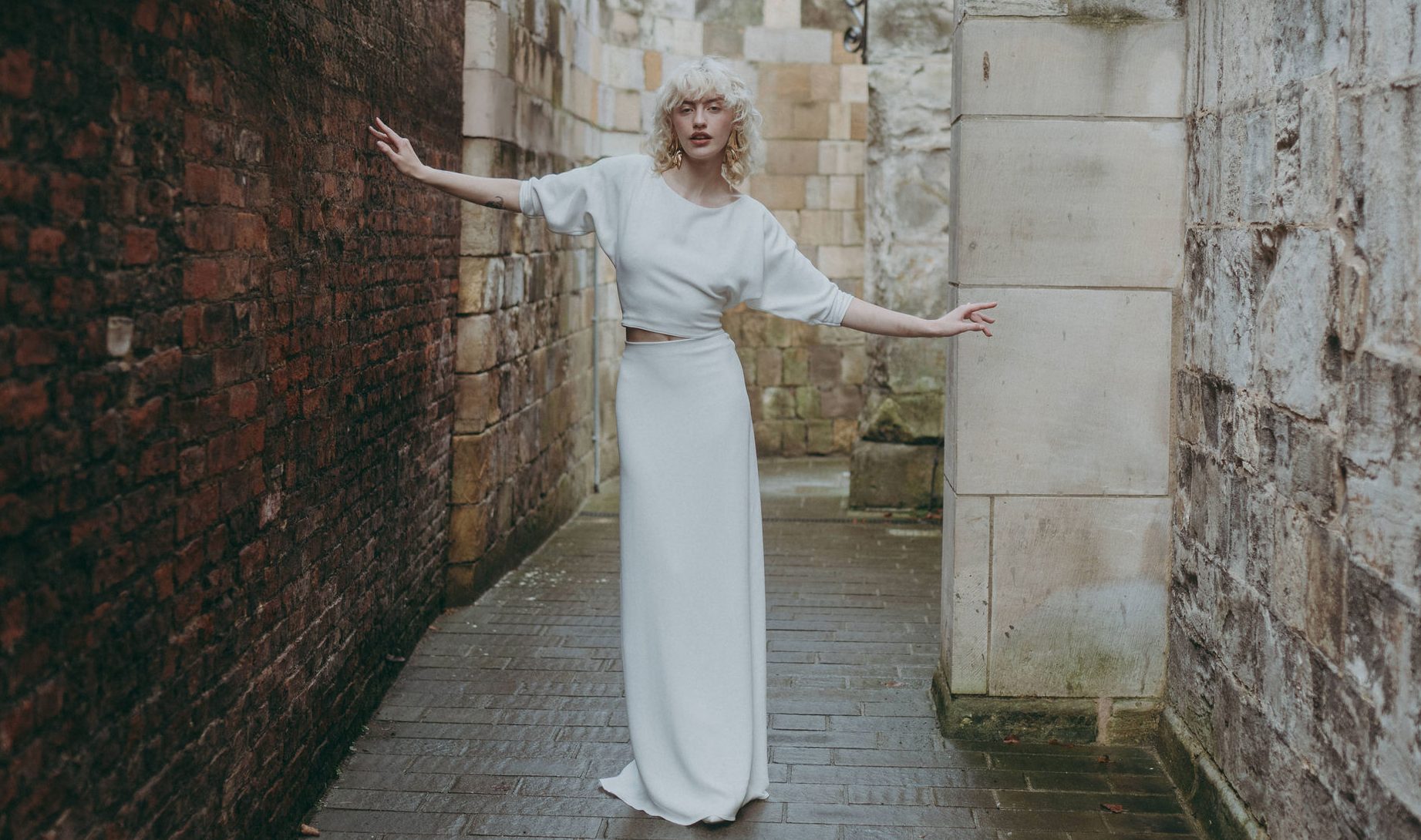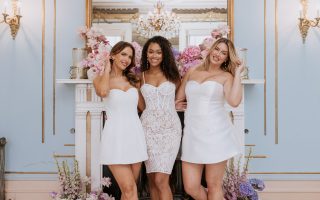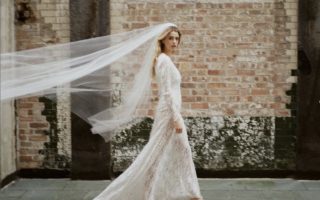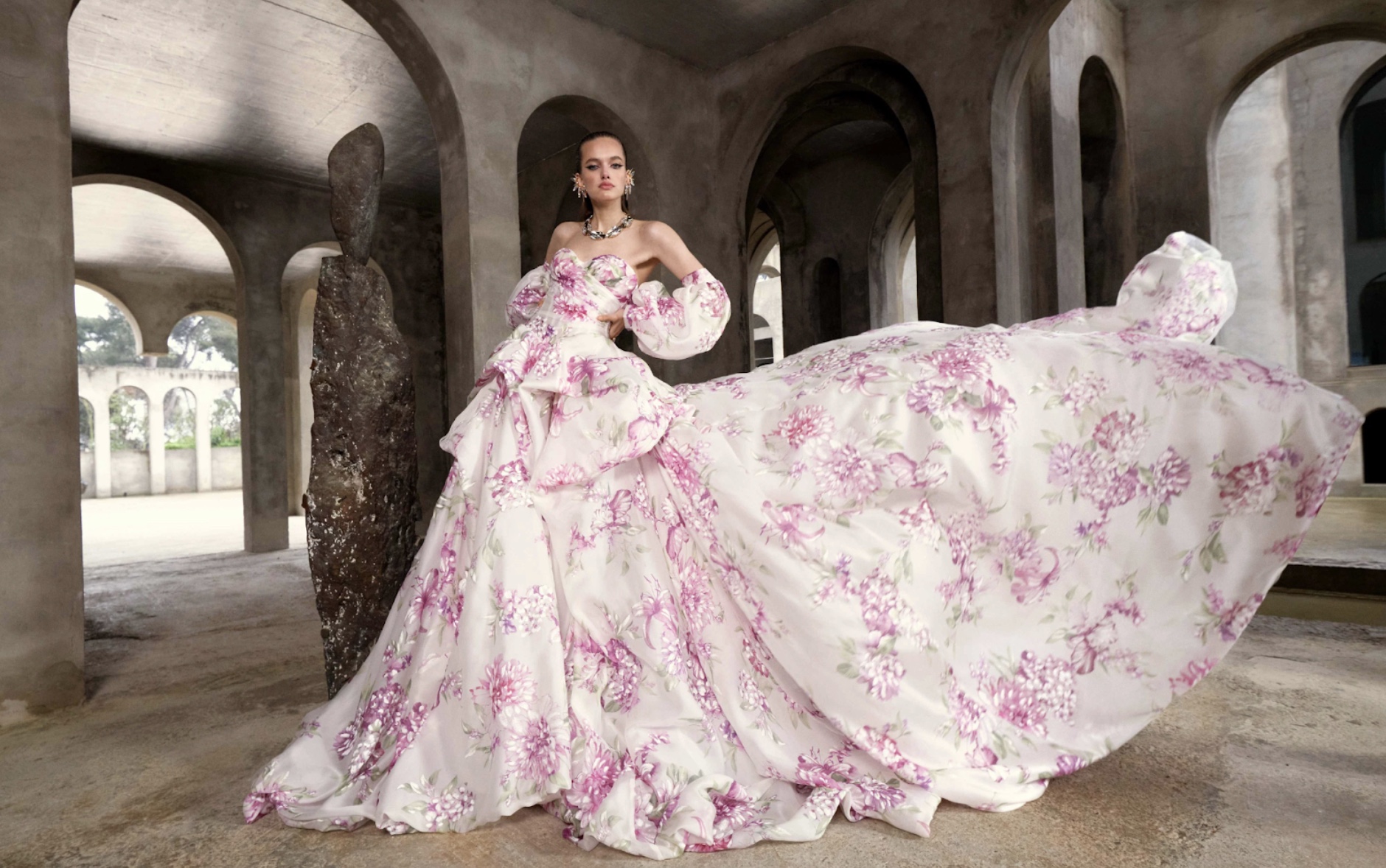Yes, it’s true: your bridal outfit really doesn’t have to cost the earth.
Your bridal ensemble is the most memorable outfit you will ever wear, but it’s also potentially the least worn. With many wedding gowns made from petroleum-based synthetics, shipped across continents, and destined for long-term storage (or worse, landfill), the environmental footprint of saying ‘yes to the dress’ is much bigger than many brides realise. But whilst the ‘wear-once’ principle of bridalwear is undoubtedly damaging, as mindsets change and brands begin improving their efforts to reduce their carbon footprint and prioritise ethical consumption, there is ample opportunity to be sustainable in your bridal gown decision without compromising on style. The most important thing is ensuring that you are equipped with knowledge before you begin this process, and luckily for you, Bridal Style’s sustainability guide has everything you need to know. If protecting the planet is a priority for you, these are the most important things to keep in mind when shopping for your wedding dress:
Be finicky with fabrics
One of the most vital elements to consider when seeking a sustainable wedding ensemble is the fabric composition of the gown or outfit that you select. “Wedding dresses can be made from a wide variety of fabrics, and all fabric requires water during the manufacturing process. The environmental impact mainly comes from the production of the outfit’s raw materials,” explains Michelle Miles, founder of The Sustainable Wedding Alliance. Therefore, to reduce your environmental impact, it’s exceptionally important to select a bridal ensemble made from low-impact, natural or recycled fibres. If you want to avoid synthetics totally, look out for gowns composed from organic cotton, hemp, organic linen, lyocell and cupro. For vegans, peace silk is a great option, as it is harvested without harming the silkworms, offering a more ethical alternative to traditional silk. Many designers also use deadstock fabrics, derived from fashion houses or mills that would otherwise go to waste, providing them with a second life.
Another option for sustainable fabrics is to investigate whether or not the fabric was created using a closed-loop process. Designer Hayley Neil of Rolling in Roses, who is renowned for her sustainability commitments, regularly uses these within her collections whenever she can, in order to minimise waste, reduce water usage, and ensure that any chemicals used in production are safely captured and reused rather than released into the environment. “Viscose is basically any fabric that’s made from a cellulose space, ie plant material, which is then dissolved chemically, and then extruded into fibres to make fabric. However, not all viscose is good, because sometimes it can be the cause of deforestation,” explains Neil. “So your number one, the cellulose, needs to be certifiable that it’s regenerative, ie they’re planting more trees alongside production. And number two, the chemicals that are used in the process can be polluting the environment as well. So a closed loop one, generally, they have certification that the cellulose is from a good source, and then the chemicals and water used to produce the fabric are then cleaned and reused. So there’s no waste water and no waste chemicals, and that’s why it’s the closed loop process.”
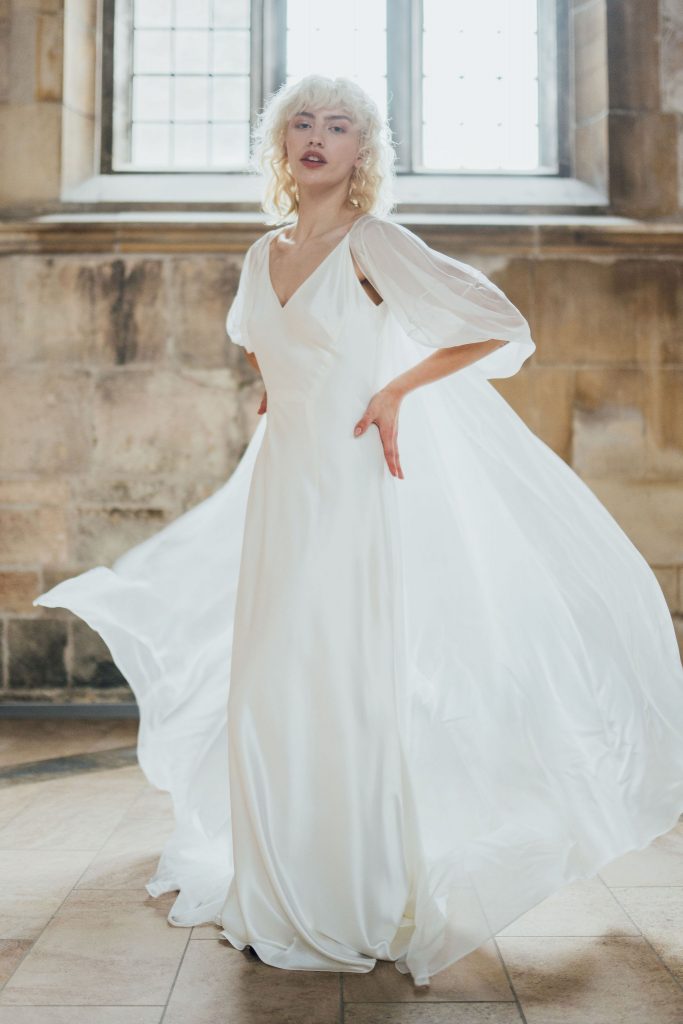
It’s also important to consider the origin of the fabric, as importing materials from overseas, especially by air, can significantly increase the carbon footprint due to high transportation emissions. With this in mind, of course the most sustainable option is choosing a certified, closed loop fabric that is made in the country you are buying from, however this is certainly easier said than done, for both a bride and a designer. “Sometimes people say, what’s the most sustainable fabric you use? But it’s not really quantifiable, because things are sustainable in different ways,” explains Neil. It might be the most perfect fabric that is, you know, closed loop and organic and all those wonderful things, but it might have to be shipped from China. So, you know, there are different ways of being sustainable, and of course people have got different priorities.”
Navigating bridal fabrics can be tricky, especially when you’re not a professional, as there are so many factors to consider to determine a material’s environmental impact. But the best thing that you can do is be inquisitive, and ask the designer you are working with about all of the finer fabric details. If they are passionate and driven by sustainability, they will be more than happy to answer any questions you may have. Many designers will also include the fabric composition of each garment on their product pages, which is incredibly helpful when assessing the sustainability of the fabrics that they use.
Choose your designer wisely
Before beginning your bridal outfit shopping journey, it’s also essential to conduct research on the designers that you are considering buying from, especially if you are keen to limit the environmental impact of your ensemble. As well as assessing whether their design style mirrors your desired bridal aesthetic, it’s important to also read up on their sustainability efforts: most designers will have a page on their website dedicated to this, but if in doubt, you can also reach out to the designer directly.
“For the bridal boutiques or designers, it’s worth looking to see if they have any sustainable business accreditations or certifications, look for the Sustainable Wedding Alliance Accreditation or B Corp certification,” explains Miles. If a designer or boutique has one of these credentials, it’s a strong indication that they’re genuinely committed to ethical practices. It’s also worth noting the scale that the designer works at, and whether the gowns that they create are pre-made or made to order. Alongside allowing for greater attention to detail and craftsmanship, smaller scale, made to order production will also result in less waste: “Made to order bridal is inherently more sustainable than mass produced fashion, because things have been made individually to order so that there’s no overproduction,” says Neil. “There is a lot of bridalwear that is made like that, and there is a lot of waste, just as there is in the normal fashion industry. But made to order bridal is inherently better than mass produced garments.” Although the lead time for your bridal ensemble will be longer, a made to order gown will certainly be worth the wait when you have that reassurance that it has been made with the health of the planet at heart.
Alongside consideration of their commitment to environmental sustainability, it’s also vital to read up on a designer’s ethical practices, to ensure the wellbeing of the artisans behind your gown, as well as the planet. This begins by investigating where and how their garments are made, and looking for transparency around their supply chain. The key questions to consider are: do they produce locally or outsource to factories overseas, and are the working conditions of their employees safe and fair? Ethical designers will often share information on their website about how they operate, their production partners and their commitments to ensuring that their employees have a happy work environment.
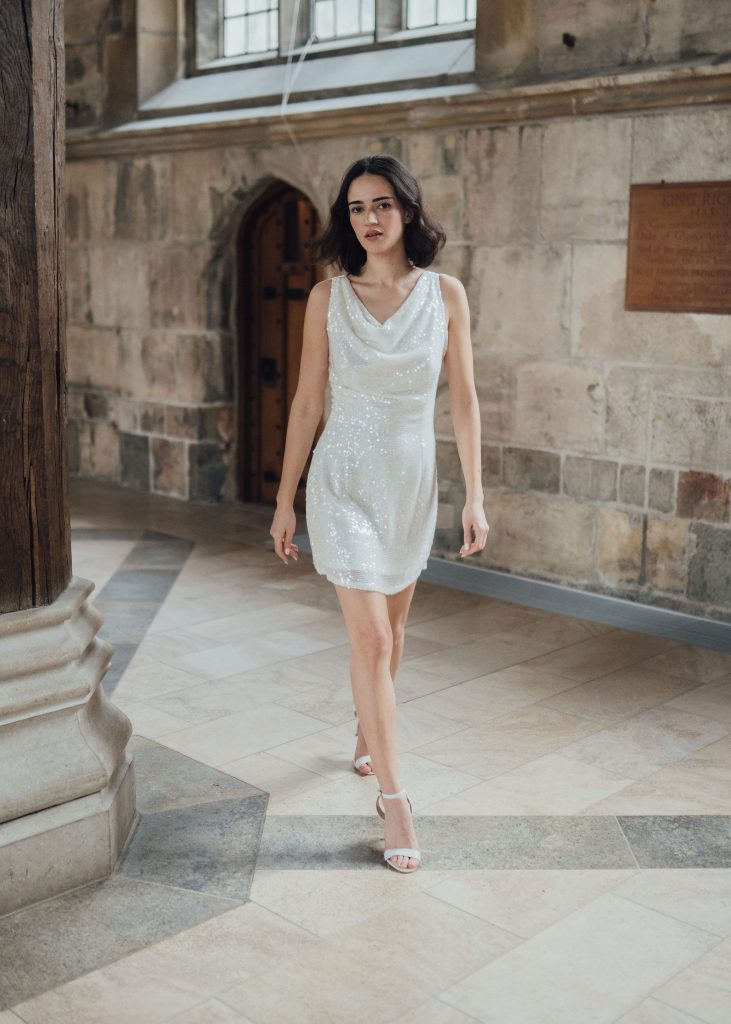
Selecting a genuinely ethically and environmentally friendly designer is becoming more and more tricky, as unfortunately many brands are jumping in on the sustainability bandwagon to lure in conscious brides, without actually putting in the effort. This practice, known as greenwashing, can make it difficult to distinguish between genuine commitments and clever marketing. The key is to be cautious of vague language like “eco-friendly” or “sustainable” without clear explanations or proof. Instead, look for specific details, such as certifications, transparent supply chains, and thorough information about fabric sourcing and production methods, as collectively these signal a brand’s true dedication to responsible practices.
Another trick not to be fooled by is a misleading claim that sounds sustainable, but is actually just standard industry practice in disguise. “A lot of companies say that they minimise waste when they’re cutting out patterns, which is a bit of a bugbear of mine actually, because whenever you’re making fashion, economically you aim to minimise the wastage of fabric. Everybody does that, even Shein does that, it’s not something to be proud of,” says Neil. Many bridal labels will also emphasise within their marketing where their garments are designed, and not mention where they are actually manufactured. These claims are also deceiving, as after reading this brides would assume that they are created in the same place that they are designed, however this is often not quite the case. For example, a bridalwear label might claim their gowns are designed in London, but in reality, the dresses could be manufactured in China, resulting in substantial carbon emissions from international shipping and air transport. So it’s vital to stay cautious, and not be afraid to look beyond the buzzwords. Genuine sustainable designers won’t shy away from sharing these details: in fact, they’ll welcome your curiosity and praise you for your inquisitiveness as it proves that you’re also genuinely interested in making a difference.
Think about re-wearability
The idea of being able to re-wear your bridal gown after the big day is certainly an exciting style possibility, but it’s also a great way to extend the life of your dress, reduce waste, and make a more sustainable fashion choice. The ‘wear once’ expectation of the wedding dress is swiftly becoming a thing of the past, as brands and designers are coming up with creative ideas that enable you to incorporate your bridal gown into your post-wedding wardrobe. Because let’s be honest, who really wants to tuck their cherished bridal ensemble away in a box, never to see the light of day again?
The re-wearability of your bridal ensemble is something you should consider right from the beginning of your dress shopping journey. “Before buying a dress, think about what you will do with it after the big day. Can it be repurposed so that you can wear it again, perhaps as separates, or dyed to look like a different dress?” says Miles.
One of the easiest ways in which you can extend the life of your bridal ensemble without changing the original design at all is to opt for separates, as opposed to a traditional gown: “From a sustainability perspective, separates are more likely to be worn again, as the separates are much more inherently flexible in terms of what you can wear them with. That’s why many brides buy separates these days,” explains Neil. Whether you pair your bridal bodice with your favourite jeans for a night out on the town, or wear your tailored bridal trousers for a smart-casual office look, finding creative ways to restyle your wedding pieces adds both versatility and value to your investment. Plus, giving your wedding outfit a second life is a stylish way to embrace sustainability and reduce fashion waste.
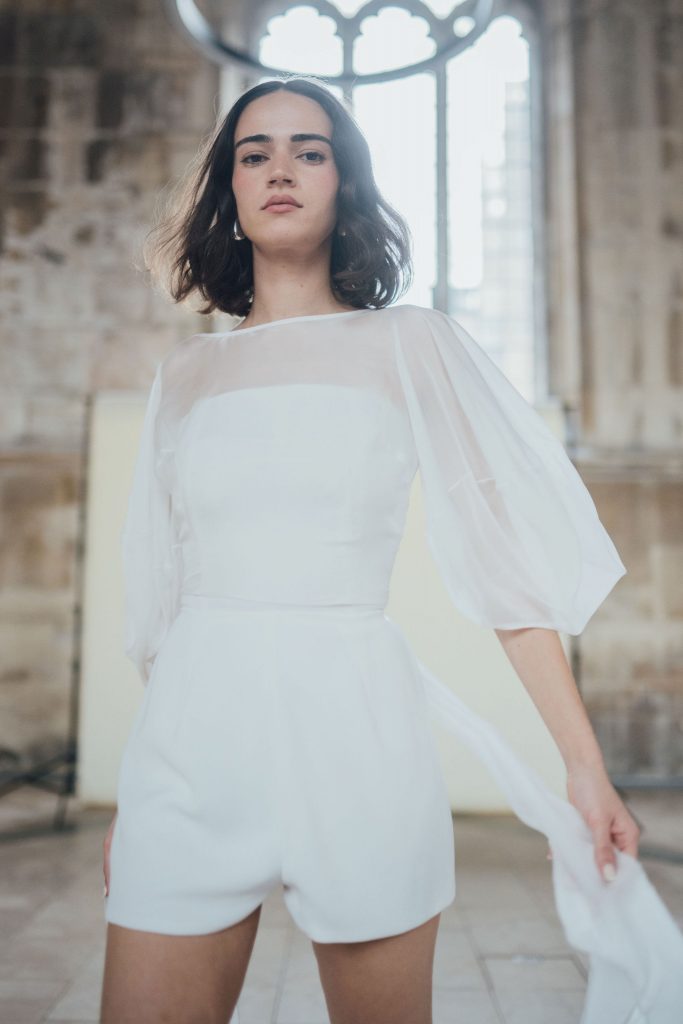
If you’re set on the idea of a traditional, full length bridal gown and are willing to get a bit more creative, there is certainly nothing stopping you from making adaptations to your bridal gown so that you can wear it again for future occasions. Many designers and tailors offer repurposing services, providing brides with the opportunity to transform their bridal gown into a more wearable garment that they will treasure forever. The possibilities will of course depend on the style of gown that you choose, and you can always enquire with the designer about this in advance, before you solidify your decision of what to wear for your big day. Some brides will choose to cut their bridal gown, transforming it into a short dress that they can rewear for special occasions, such as their anniversary. You can even transform a full bridal gown into versatile separates: wear the bodice on its own for future occasions, while the skirt can be shortened to become a more practical, rewearable piece.
And who says you have to stick with the initial colour of your bridal ensemble when repurposing? If you’ve opted for a traditional white or ivory hue, you can definitely explore the possibilities of dyeing your wedding dress or separates to make it even more rewearable. “We’re always trying to persuade brides to dye things and repurpose them after. We do dye tests on all of our fabrics, so we can advise people on what can be dyed afterwards,” says Neil. That being said, if you’re set on the idea of dyeing your bridal ensemble after your big day, it’s wise to consult with your stylist or designer about the possibility of this before you make your decision, as some fabrics take to dye more seamlessly than others.
Of course it’s a risk to make adaptations to a dress that is so special, but it’s certainly a risk worth taking, especially from a sustainability perspective. “I think people are too timid to do it, and then the dress just hangs in the wardrobe for the next 20 years, and it’s a bit of a waste. And if you’ve paid all this money and had this amazing experience, choosing a dress that you love and having it fitted perfectly to you, it’s such a shame to not use it again,” says Neil. “If you have a dress and you change it into a bodice and a skirt, every time you wear that bodice, you’re going to think of your special day. So it makes it something that’s really sentimental.”
Consider a rental or preloved option
If you’re seeking both a sustainable and affordable alternative to buying a dress outright, the rental or preloved route could be the perfect avenue to go down. “Pre-loved dresses are popular and a great option if you’re looking for a sustainable option,” says Miles. “Rental is also on the rise in bridal, with rental websites like ByRotation offering bridalwear options.”
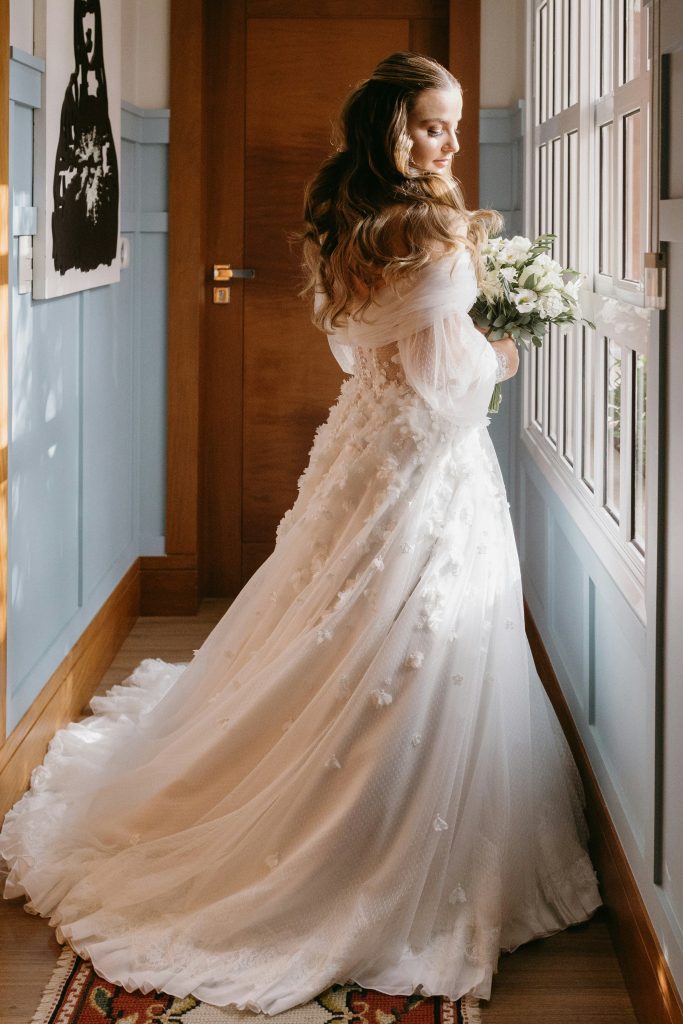
These platforms allow you to rent a designer bridal gown at a fraction of the retail price, for a set period, typically a few days surrounding the wedding. With a wide range of styles, sizes and designers available, rental services make high end bridal fashion more accessible, while significantly reducing the environmental impact of single use garments. It’s an ideal option for modern brides to wear their dream dress on their wedding day whilst staying in budget and making an eco conscious choice.
Simultaneously, opting for a preloved or vintage wedding dress as opposed to a new gown offers the opportunity to reduce your environmental footprint, as well as opening up access to designer pieces at a more affordable price point. Preloved dresses can be even more special than a brand new gown, as they carry a unique history that infuses your look with a sense of story and sentiment. Still White is an amazing platform for buying preloved and second hand bridal gowns, as well as PS Bridal and Bridal Reloved.
As well as honing in on aesthetics, it’s vital to also tap into your conscious values when wedding dress shopping, to ensure that you truly resonate with not only the outer appearance of your bridal outfit, but the story behind its creation. With the plethora of options available, the opportunities to find the perfect sustainable bridal ensemble are truly endless. The key to navigating the world of sustainable bridalwear is being informed, and paying close attention to the details that reveal a brand’s true commitment to ethical and eco-friendly practices.
“I think asking questions is the key. And if you’re asking questions, if it’s somebody who’s the designer and maker, they can answer all of that,” says Neil. “If it’s a shop that stocks other designer’s dresses, it’s going to encourage them to ask questions, which is going to hold everyone to account, and it’ll mean that people will try harder, to be better.”
